Winter is the big flocking season in the Pacific Northwest. In summer, breeding birds spread out to nest, usually forming defended territories, but in winter, what takes priority is surviving challenging conditions. Terrestrial birds like robins, juncos, bushtits, siskins, blackbirds, turkeys also form winter flocks but I’m focusing on aquatic coastal birds since that’s who I see most of the time. The principles apply across birds in general though.
A flock is a group of birds but not all gatherings of birds are flocks. In a flock, the birds behave collectively as a whole, although there’s no central coordination per se. So the gathering of twenty eagles I saw perched on a headland isn’t a flock; every eagle just happened to find it a good spot to stop for a time before each went off on its own way. Flock cohesiveness is on a spectrum though so sometimes it’s not always clear how flocky a group is.
Flocks are fluid in composition, gaining and losing members. But at any given time the group acts more or less as a unit, which gives an individual bird advantages over being solitary (same for a school of wrasses, a swarm of gnats, or a herd of wildebeest).
So what are these advantages? I can illustrate using examples I’ve seen this winter here in western Washington where I live. There’s overlap among these of course.
All these photos and videos are from the current winter of 2023-24.
Reducing predation
Shorebirds are classic flockers, often gathering in huge numbers for protection while foraging and during migration because thousands of little birds sharing the same lifestyle become an attractive target as a meal. Most shorebirds are just passing through the PNW in fall and spring, like these Long-billed dowitchers on a piece of driftwood below. Most of them are snoozing, with one eye open, and all are facing the same direction. The moment any one of them senses danger, they’ll all take off at once, flying as a unit.
 November 26. Dowitchers at Hayton reserve, Fir Island, Skagit River delta
November 26. Dowitchers at Hayton reserve, Fir Island, Skagit River delta
A few kinds of shorebirds can be seen through winter. A small flock of dunlin came by my neighborhood recently during the deep freeze for a few days (title image above) foraging along the edge of the beach, but over on the Skagit flats, a flock of about 5000 dunlin are resident all winter, variously on fields, wetlands and shallow bays. If you’re lucky, you cross paths with the flock, but if you don’t, you’d never know dunlin were around at all. Our mainland trips, which always include a stop on the Skagit flats if we can possibly manage it, are infrequent, so there are some years I don’t cross paths with the dunlin at all. This winter I got super lucky. Saw the flock two days in a row in November, on our way down to the city and back the next day. And then again just a few days ago!
Video is the best way to see how the dunlin fly as a unit. The first video is over a field, the second is over a muddy bay where there were a couple of what I assume were falcons chasing them, if only visible intermittently.
.
You’d think a massive flock flying in close formation like this would be easy pickings for a predator, but in fact the larger and more dense the flock, the more errors predators make in targeting a prey bird. Part of the strategy is more eyes to keep watch for an incoming predator, but much is just to create a distracting target, ie the “confusion effect“. In a 2010 study, researchers using videos of starling murmurations and a mathematical model discovered that even though a flock has no leader or plan, the entire group acts as a complex dynamic unit by each individual bird tracking and adjusting to the movement of just its seven nearest neighbors at any given moment….all the while flying as fast as it can. And somehow all the birds are aware of the flock as a whole, even birds in the center, visually and instantaneously. The net effect is a stunning example of collective intelligence and awesome beauty.
.
One of the many amazing things about being under a flock like this is the sound it makes close up when the birds anren’t actually calling. It’s a fluttery whispery sussuration from their thousands of wings, which unfortunately doesn’t come across in the video. If you’ve never heard it, find a flock of shorebirds!
I’ve noticed shorebirds will forage together but they often seem to fly in a species group. Like with this mix of birds at the same site on Fir Island: they look quite unsorted on the mudflat but then all the yellowlegs take off, or all the dowitchers. They are obviously in close communication amongst themselves regardless who else they’re cheek by jowl with on the ground.
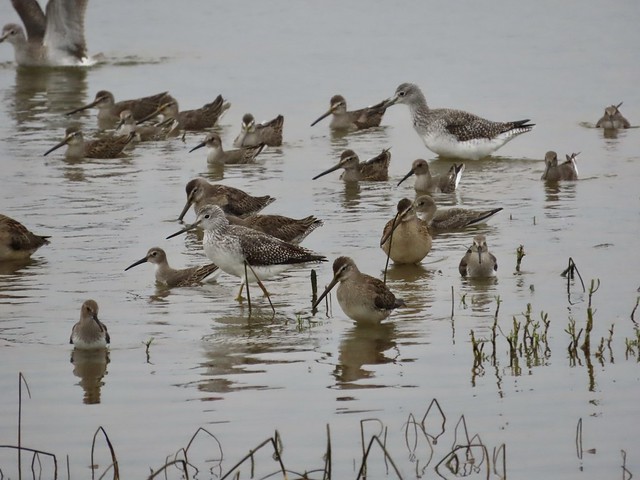 October 21. Greater Yellowlegs, Long-billed dowitchers, Dunlin. There were also Least sandpipers nearby.
October 21. Greater Yellowlegs, Long-billed dowitchers, Dunlin. There were also Least sandpipers nearby.
The other category of birds who regularly flock by the seashore here are the waterfowl: ducks, geese, and swans.
Geese:
I can’t distinguish individuals in a flock but in our neighborhood wintering flock of Canada geese, some are obviously coming and going since their numbers vary, from 80-120 this year (other years up to 200). Occasionally other kinds of geese join the Canadas for a day or for weeks, and then it’s possible to track those bird’s movements. I imagine that to a random lone goose, it’s any port in a storm, since it’s safer than being on their own. I always hope they’ll find other Snows or White-fronteds or Cacklers when they leave.
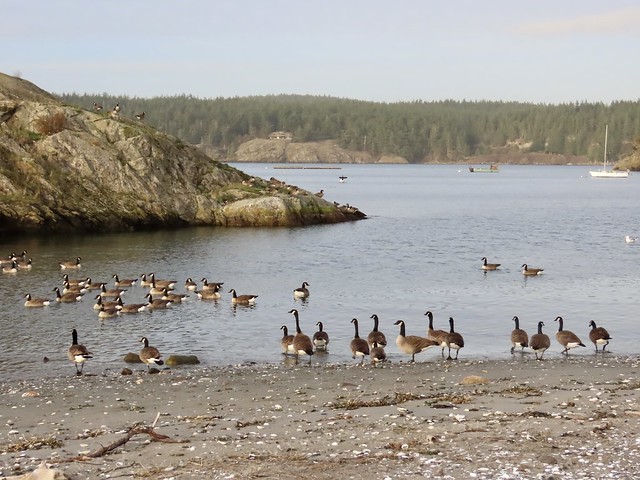 December 3. One of these geese is not like the others
December 3. One of these geese is not like the others
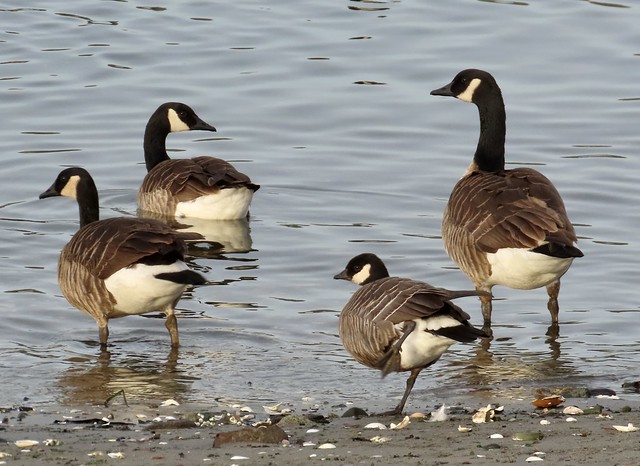 Lone Cackling goose with Canadas
Lone Cackling goose with Canadas
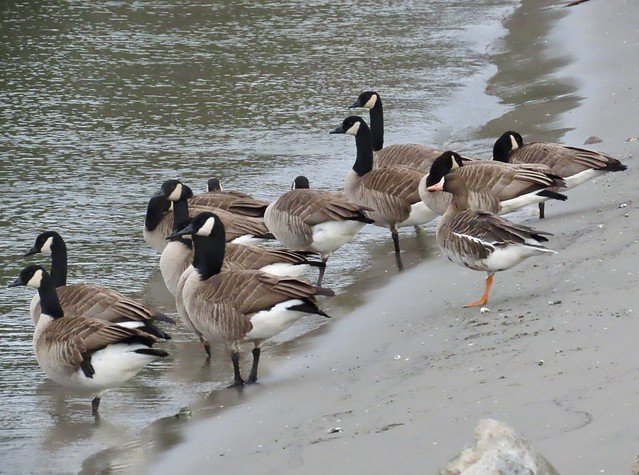 December 30. Lone White-fronted goose was around for a week
December 30. Lone White-fronted goose was around for a week
 January 9. Snow geese on the Skagit flats, seen from Highway 20 near the Swinomish channel. Several thousand birds.
January 9. Snow geese on the Skagit flats, seen from Highway 20 near the Swinomish channel. Several thousand birds.
Ducks:
Sometimes ducks cruise around as onesies or fewsies, but usually they’re in flocks of tens or hundreds (and occasionally thousands, ie mallards). This is true for both diving ducks and dabblers.
 November 16. American wigeons, Ship harbor, Anacortes. They were scarfing down sea lettuce and suddenly all looked over at an eagle going by.
November 16. American wigeons, Ship harbor, Anacortes. They were scarfing down sea lettuce and suddenly all looked over at an eagle going by.
 October 11. Mixed flock of Surf scoters and White-winged scoters, who like foraging over the same kind of sea bottom
October 11. Mixed flock of Surf scoters and White-winged scoters, who like foraging over the same kind of sea bottom
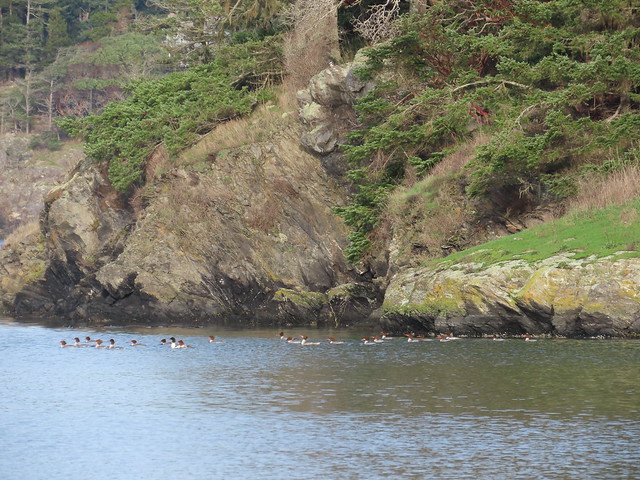 January 1. Common mergansers. Kind of unusual seeing them in the saltchuck, they’re far more common in freshwater.
January 1. Common mergansers. Kind of unusual seeing them in the saltchuck, they’re far more common in freshwater.
Note how the Red-breasted mergansers in the video below are grooming as a flock. Some are fully engrossed, others are intermittent, and still others are just keeping an eye out in general. So long as somebody is alert, others can be more efficiently busy than if they have to constantly pause to check for raptors, mink or other predators. Most if not all of these are first year ducks.
.
Alcids:
Same group strategy as the waterfowl. The biggest flocks of murres I see are after fledging season, when youngsters certainly benefit from group protection, but they form flocks in winter too.
 November 17. Winter flock of Common murres
November 17. Winter flock of Common murres
More efficient flight
Migration is incredibly energy intensive. Many birds fly hundreds or thousands of miles a day from their summer breeding territories to where they spend the winter, without much downtime to stop and refuel. But migrating in a flock reduces their energy expenditure to 20-30% and increases their range by 71% when they fly in a V-formation. The goose in front does the most work, pushing air aside, and each following bird uses the upwash created by the wingtips of the goose in front and to the side to benefit from that lift. From a study of migrating ibises:
Lead researcher Dr Steven Portugal explained: "They're seemingly very aware of where the other birds are in the flock and they put themselves in the best possible position.” This makes the most of upward-moving air generated by the bird in front.
"Downwash is bad," explained Dr Portugal. "Birds don't want to be in another bird's downwash as it's pushing them down.” But as the air squeezes around the outside of the wings, it creates upwash at the wingtips.
"This can give a bit of a free ride for the bird that's following," said Dr Portugal. "So the other bird wants to put its own wingtip in the upwash from the bird in front."
From everything I’ve read, there’s no single lead goose; rather, as one gets tired they rotate up another goose. You have to wonder how that decision is made in a group with no leadership or organization. Communication is critical though. They talk amongst themselves constantly as they fly.
I often see ducks and grebes in large groups when they first arrive, and then they gradually break up into smaller groups. For example Horned grebes arrive in October a flock of 20-30 but are mostly in twos or threes now. However Snow geese remain in big flocks throughout the winter. While here they are not covering much ground, but they still arrange themselves in lines anyway as they move around during the day.
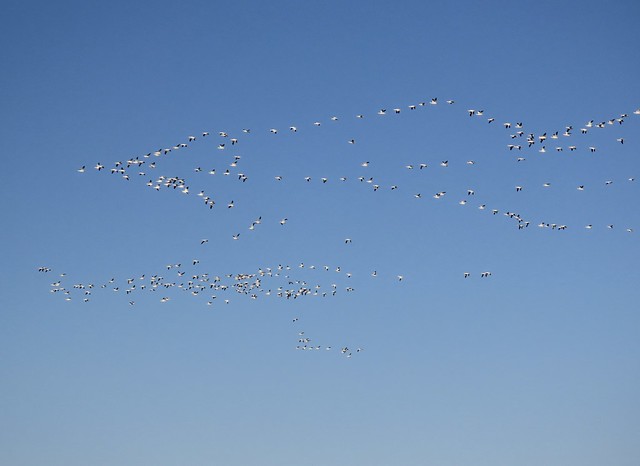 November 23. Snow geese at Fir Island.
November 23. Snow geese at Fir Island.
The first half of this video is Snow geese moving from one field to another during the day, the second half is near sunset as they head to their night roost.
.
An aspect of flying efficiency I can appreciate is how neatly birds that hang out in a tight group are able to take flight so quickly without running in to each other. The burst mode on my camera showed how a flock of buffies shifted from floating quietly to everyone getting airborne to reforming as a group all flying the same speed and direction (ultimately to land elsewhere on this bay). A few frames:
 Somebody decided to go
Somebody decided to go
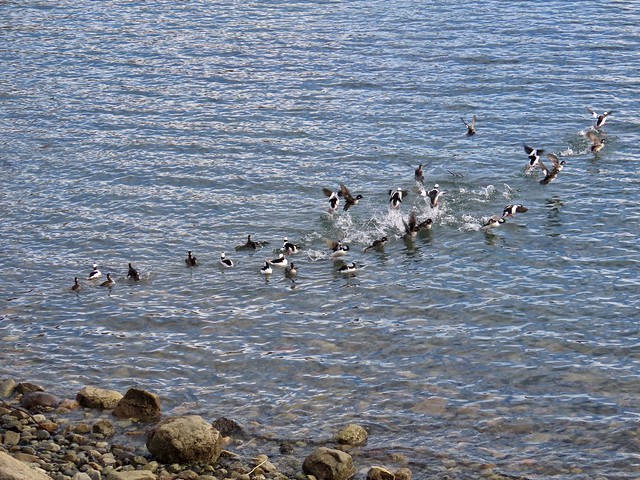 Everyone else turns and takes a couple of steps to get airborne (buffies are almost as quick lifting off as dabbling ducks)
Everyone else turns and takes a couple of steps to get airborne (buffies are almost as quick lifting off as dabbling ducks)
 Some go left, some go right. That way nobody runs into another duck.
Some go left, some go right. That way nobody runs into another duck.
Foraging cooperatively
You’d think having conspecifics hunting in the same area would mean competition, but evidently the advantages of a flock outweigh that. Both Red-breasted and Common mergansers frequently cruise the shallows near the beach in a row, periscoping, stirring up any fish below, herding them forward and then diving to snag one (sometimes they fight over who gets it). White pelicans use this strategy too.
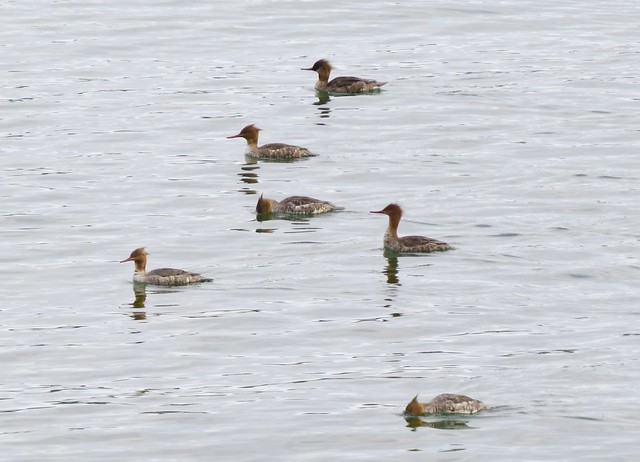 February 2. Red-breasted mergansers
February 2. Red-breasted mergansers
Less organized but certainly opportunistically flock-like, gulls keep an eye out for any activity and join in an attack on food sources like herring or sand lance. These small fish form a concentrated mass called a baitball when they are herded from below into a tight ball at the surface by cormorants, alcids or seals, and from above by gulls circling around on the sides. Fish “flocks” (ie schools) are as advantageous as birds flocking, but under heavy active attack their collective structure loses integrity, making them vulnerable to predation until they can regroup. Gulls pick them off at the surface. After a few minutes the fish break away from their dense concentration and the baitball frenzy disperses, though often reforms a short distance away as underwater predators start panicking them again.
 This was a mixed flock of Glaucous-wingeds, Bonaparte’s and Mew gulls.
This was a mixed flock of Glaucous-wingeds, Bonaparte’s and Mew gulls.
.
Gulls are supremely opportunistic, and their flocks seem more form than function, frankly. But gulls are preyed on by eagles and they’re a lot less likely to get picked off if it’s a whole lot of gulls descending on a crab boat or baitball, even if the price is squabbling over the food source.
 Flock of gulls following a crab boat. Crabbers toss old bait into the water.
Flock of gulls following a crab boat. Crabbers toss old bait into the water.
Breeding: pairing opportunities
Ducks mostly pair up in winter before migrating to where they breed up north or inland. A flock is like a big party where you can strut your stuff — drakes can persuade hens he’s the one. Mergansers have the most extreme acrobatics.
 November 1. Hooded merganser drakes posturing, impressing the ladies. Red-breasteds are even more acrobatic but they won’t start that until March or April.
November 1. Hooded merganser drakes posturing, impressing the ladies. Red-breasteds are even more acrobatic but they won’t start that until March or April.
Sometimes the showing off and shoving matches can get pretty intense. Check out the bufflehead drakes in the video. Buffies start doing this almost as soon as they arrive in November.
.
Protection from extreme weather
In the maritime Pacific Northwest extreme weather is rarely a problem, but occasionally in winter we get severe storms with wind or cold. In fact it was a sudden major windstorm on January 9 that gave me the idea for this Dawn Chorus topic. We were down in Oak Harbor on Whidbey Island for an appointment, had some down time and stopped by the bay there to see what birds were about. Besides various ducks and gulls, I was gobsmacked when a big flock of black shorebirds flew in and landed on the beach.
 They are tucked in amongst the driftwood so I couldn’t get an exact count but there were at least 50
They are tucked in amongst the driftwood so I couldn’t get an exact count but there were at least 50
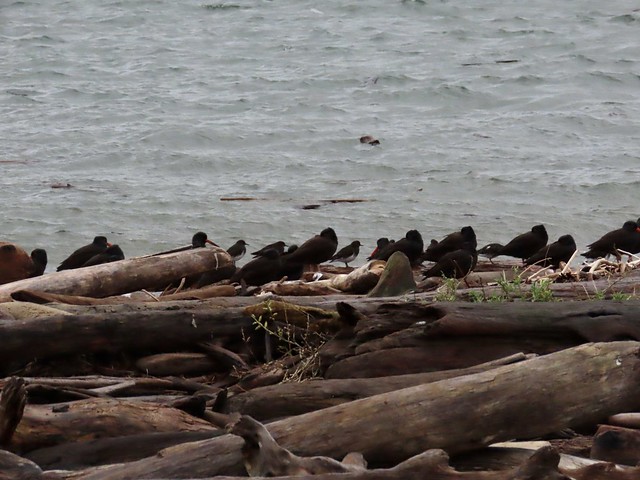 All facing west, into the wind, mostly with heads tucked under wings. Some Black Turnstones amongst them.
All facing west, into the wind, mostly with heads tucked under wings. Some Black Turnstones amongst them.
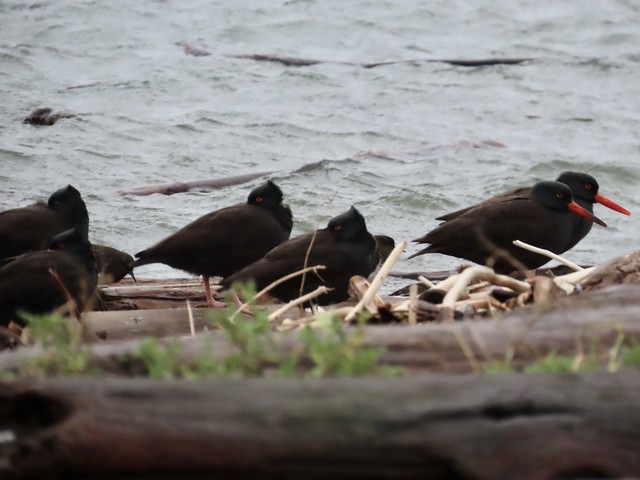 Black Oystercatchers!
Black Oystercatchers!
I’ve never seen that many oystercatchers at once before, maybe a dozen. Oystercatchers usually occur in ones and twos in summer, and small flocks in winter. Clearly every oystercatcher in the area had congregated for safety in the 50mph wind (gusting 70+, I had to hold onto a lamppost to get those photos). A lot of them were juveniles.
Killdeer are also not typically flocking birds, but in winter it’s more likely to see flocks bigger than 6-8 birds. In December a flock of about 35 took refuge in a quiet bay near my house for about a week.
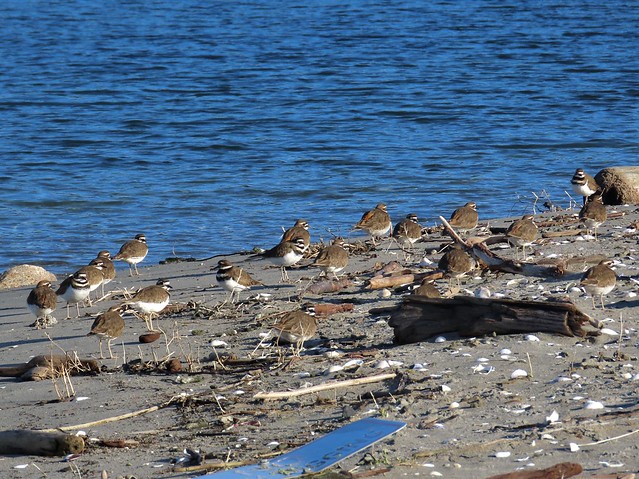 December 26. Part of the flock. In a larger view they would be invisible against the sand
December 26. Part of the flock. In a larger view they would be invisible against the sand
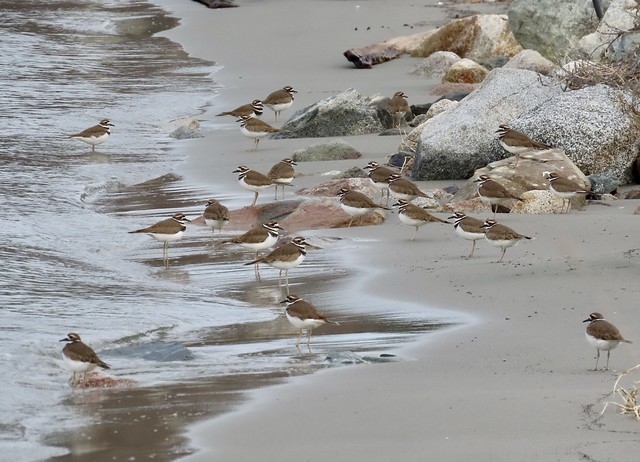 December 27. Same bay. I can’t tell juveniles from adults among killdeer but it’s likely there’s a mix
December 27. Same bay. I can’t tell juveniles from adults among killdeer but it’s likely there’s a mix
Our weather this fall and early winter was extremely dry, unprecedented. The wetlands didn’t fill up until the rain started in earnest in January. Until a few weeks ago, the swans who come back to the island every winter were stuck foraging in the shallows of our one lake.
 December 10. Trumpeter swans this winter have come in even numbers: 6, 10, 12
December 10. Trumpeter swans this winter have come in even numbers: 6, 10, 12
.
Swans have no predators, don’t hunt down prey, and they mate for life, so we might ask why they form a flock like this, when the advantages listed above do not apply. Swans typically flock like this, sometimes several hundred birds, across the lowlands of western Washington.
Close proximity to many other birds can have downsides, like competition for food, greater visibility to predators, the spread of disease, or vulnerability to localized catastrophes. We all know of birds who are generally loners or hang out in pairs (like Red-necked grebes, Glaucous-winged gulls). But even for those kinds of birds, ad hoc flocks form, as with the Trumpeter swans. Sometimes the advantages of being in a flock are obvious, sometimes more mysterious — maybe they just like being sociable? — but the dynamic nature of flocks makes winter a fascinating time for birders in the Pacific Northwest.
The Dawn Chorus is now open for your birdy reports of the week.


